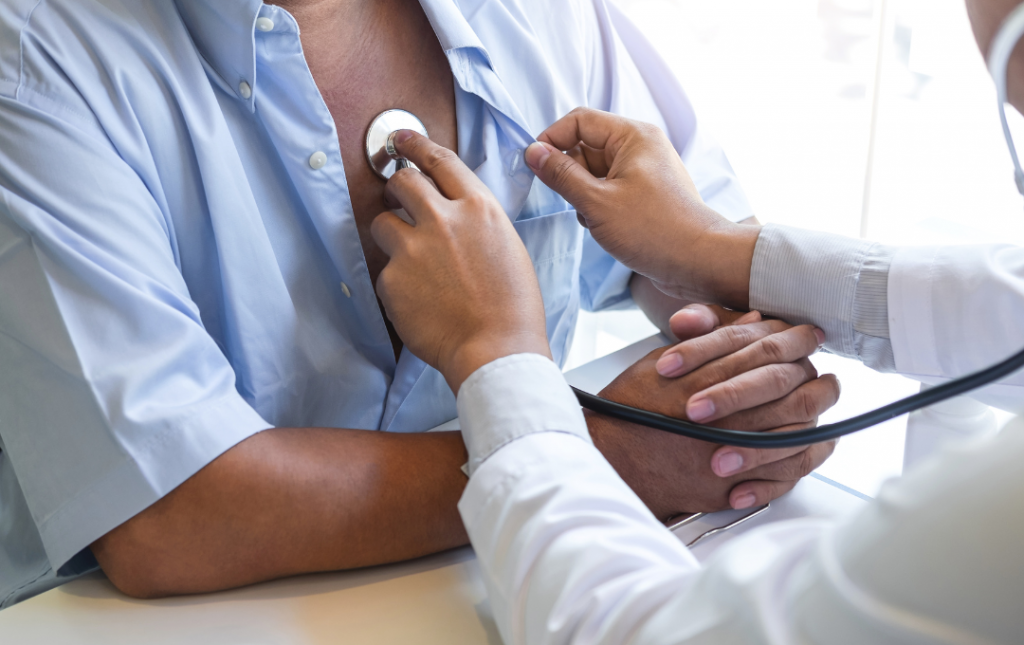February is American Heart Month, a time to prioritize heart health and understand the dangers of heart disease. Heart disease encompasses various conditions, including coronary artery disease, arrhythmia, and peripheral artery disease (PAD). Coronary heart disease and PAD share similar risk factors like atherosclerosis—the narrowing of arteries due to a fatty substance buildup. As these diseases progress, you can develop complications such as heart attack and stroke.
The American Heart Association notes that over 900 thousand people die from heart disease. Taking steps now to maintain a healthy heart can lower your risk of deadly complications associated with heart disease. Let’s learn more about heart disease and PAD and how you can participate in American Heart Month.
American Heart Month Facts: Heart Disease and PAD
The American Heart Association says nearly half of adults in the U.S. have some form of heart disease. Coronary artery disease is the most common type of heart disease.
Coronary artery disease and peripheral artery disease (PAD) share similar characteristics. They can both be caused by atherosclerosis.
Atherosclerosis happens when cholesterol, fat, calcium, and other substances form plaque inside the walls of arteries. This narrows the arteries and restricts blood from reaching the rest of the body. In addition to atherosclerosis, coronary artery disease and PAD share risk factors.
Who’s at Risk for Heart Disease and PAD?
People are more likely to develop heart disease or PAD if they have the following risk factors:
- Over the age of 50
- Smoke or used to smoke
- Have high blood pressure or cholesterol
- Diabetic
- Overweight or obese
- Inactive lifestyle
- Poor diet
If you fall under one or more risk factors, see a vascular specialist to get screened. Early detection and medical intervention can help reduce your risk of heart attack or stroke.
Understanding Symptoms of PAD During American Heart Month
Unlike the risk factors and complications, PAD and coronary heart disease have different symptoms. The most common symptom of PAD is leg pain during physical activities like walking. The pain stops while resting in earlier stages. In later stages, the plaque in the arteries can block blood flow to the legs and feet. When this happens, leg pain will persist even after resting.
If PAD is left untreated, the risk of critical limb ischemia increases as well as the need for prompt medical attention. Critical limb ischemia means that there’s a severe reduction in blood flow, contributing to leg pain even after resting. Non- or slow-healing sores may form in the feet, increasing the risk of infection. When tissues in the legs and feet become infected and die, the result is gangrene, meaning that the dead tissue needs to be amputated before it spreads to the rest of the body. If you are experiencing leg pain accompanied by difficulty walking, shiny skin on the legs, or cold legs and feet, schedule a consultation with a vascular specialist.
Treatment for PAD at USA Vascular Centers
USA Vascular Centers specialize in diagnosing and treating PAD, a form of heart disease. Its state-of-the-art facilities have tools like ABI testing to ensure an accurate diagnosis. Its highly skilled vascular specialists offer a combination of minimally invasive PAD treatments to widen the arteries and improve blood circulation. Additionally, USA Vascular Centers participates with most major insurance plans and can verify your insurance instantly when you call or schedule online.
American Heart Month Activities: Heart Disease and Prevention
American Heart Month is the best time to start adjusting your lifestyle with heart disease and PAD prevention tips. Small lifestyle changes can improve your quality of life and help you prevent severe heart disease conditions. Let’s review ways to participate in American Heart Month and prevent yourself from developing PAD or heart disease.
1. Prioritize Regular Sleep
The American Heart Association says that irregular sleep schedules can lead to high blood pressure, raising the risk of heart disease and PAD. Health experts recommend that adults get about seven to nine hours of sleep at night. Better sleeping habits can lower the risk of heart disease, boost brain function, reduce stress and anxiety, and improve overall health.
2. Maintain a Healthy Weight
Being overweight or obese can contribute to plaque buildup in the arteries. Maintaining a healthy weight can protect you from cardiovascular diseases like heart disease and PAD. Ways to maintain a healthy weight include exercise and healthy eating.
3. Monitor Your Blood Pressure
According to the CDC, almost half of adults have high blood pressure. However, only one in four adults have their high blood pressure under control. Some patients with high blood pressure don’t experience symptoms, making this risk factor for PAD and heart disease a “silent killer.” An at-home blood pressure monitor can help you keep your blood pressure in check. Some at-home blood pressure monitors may not be accurate, but you can bring one to your doctor to have them test its accuracy.
4. Keep Your Cholesterol In Check
Attending your annual physical can help you keep your cholesterol in check. Your physical exam will include a blood test to check your cholesterol, protein levels, and blood sugar levels. Depending on the results, you may need to incorporate lifestyle changes such as changing your diet.
5. Eat Healthy
Maintaining a healthy diet goes a long way to improving your heart and vascular health. Foods high in saturated fats and sodium, as well as processed foods, can increase your bad cholesterol and contribute to plaque buildup in the arteries.
6. Quit Smoking if You Smoke
Your risk of PAD and heart disease increases when you smoke. This is because smoking constricts the blood vessels and makes the blood thicker, increasing your chance of developing a blood clot and poor circulation. Your doctor or vascular specialist can offer smoking cessation programs to help you quit.
Improving Your Heart and Vascular Health
In most cases, those with heart disease or PAD need medical interventions to help manage their symptoms and delay the disease’s progression. USA Vascular Centers specialize in minimally invasive treatments for PAD that can effectively improve symptoms and lower the risk of complications.
In addition to PAD treatment, patients may also take certain medications to reduce cholesterol and prevent blood clots. Lifestyle adjustments such as adopting a heart-healthy diet, exercising, and quitting smoking can also help you get the best outcomes after a minimally invasive PAD treatment.
Minimally invasive PAD procedures have benefits such as a shorter recovery time, little to no scarring, and fewer risks compared to surgery. Our treatments are FDA-approved and covered by most insurance plans, including Medicare and some Medicaid plans. Call us at 888.773.2193 or request an appointment online.
BOOK A CONSULTATION ONLINE TODAY
Frequently Asked Questions
How long can you live with heart disease?
The life expectancy of a person with heart disease depends on the kind of heart disease they have. The American Heart Association says heart attacks, a complication of heart disease, can impact life expectancy. Men can live 10 to 15 years after a heart attack, while women can live 15 to 20 years after a heart attack.
Can PAD be reversed?
No, peripheral artery disease cannot be reversed. However, there are lifestyle changes, medications, and minimally invasive PAD treatments can lessen the severity of the symptoms.
What are the different types of heart disease?
There are over 30 different types of heart disease, with the most common being heart failure, peripheral artery disease, and coronary artery disease. Not all types have similar symptoms, risk factors, or treatments. Those with symptoms of leg pain, shiny legs, or difficulty walking should consult USA Vascular Centers for a personalized treatment plan.




